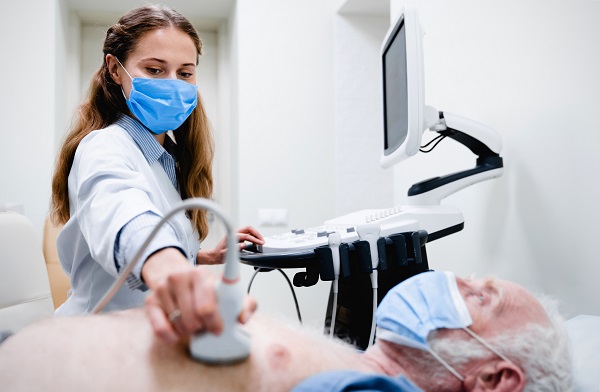By Sarah Ripplinger and Vivian Sum
The global rally to stop the spread of COVID-19 has spurred the discovery of new approaches to streamline and enhance disease detection and triaging. A recent study led by Vancouver Coastal Health Research Institute (VCHRI) researcher Dr. Teresa Tsang summarizes evidence for why point-of-care ultrasound (POCUS) technology could be a leading, next-generation part of COVID-19 care.
“The published literature we reviewed provides compelling evidence for the use of POCUS as a cutting-edge imaging tool that can be used to quickly assess the heart and lungs,” says Tsang. “This relatively novel application of sophisticated technology packaged in a small unit could complement the suite of imaging machines currently available in-hospital, and become a welcome addition to a wide variety of care settings, including family practises and long-term-care facilities in the community setting.”
POCUS emerged over two decades ago as a means of providing rapid, portable access to ultrasound technology. This non-invasive, zero-radiation technique emits high-frequency sound waves through a probe placed on a patient’s body. The sound waves bounce off a patient’s internal tissues and organs, which are then displayed as images on a tablet, computer or smartphone screen.
POCUS portable ultrasound machines use sound waves to detect abnormalities in the body’s tissues.
The technology is a more rapid alternative to traditional, larger ultrasound machines used to assess heart function, says Tsang. It has also been used to evaluate foetuses in utero and to detect solid organ tumours and cysts.
For her study, Tsang and her team examined peer-reviewed literature published up until August 2020 on the use of POCUS for diagnosing COVID-19.
“The literature we reviewed highlighted several advantages of using POCUS in COVID-19 detection,” says study first author Olivia Yau.
POCUS does not require transporting patients outside of their rooms or care facilities, notes Yau. It is relatively low-cost, is easy to sanitize and cuts down on CT scanner demand and cleaning time, which can help prevent the spread of COVID-19.
POCUS can effectively image fluid buildup around the lungs, and pneumonia and fluid congestion in the lungs, as a non-radiating alternative to chest x-rays and the ionizing radiation used in computed tomography (CT) scans.
“POCUS may be better at detecting some lung findings than x-rays; and, unlike x-rays, the technology is safe for children and pregnant women, which is another huge advantage,” Yau adds. “When it comes to long-term care, you do not have to transport the patient to the hospital, which, for geriatric patients, can avoid putting stress on the patient and their family members, especially during the COVID-19 pandemic.”
The images provided by POCUS can reveal disease severity, helping clinicians to quickly assess a patient’s condition and make treatment recommendations. For example, an image of diseased lungs typical of COVID-19-related pneumonia, combined with the presentation of other COVID-19 symptoms, could signal the need for emergency care.
This POCUS image shows signs of white lung and other indications of COVID-19-related pneumonia.
“POCUS can help with risk stratification,” says Yau. “Clinicians can see how far into the disease process a patient is, their prognosis and if they require urgent treatment versus home care, which can also help optimize resource allocation.”
While their study provided a good starting point for this line of research, more work is necessary to fill in information gaps.
“A provincial study of POCUS imaging is currently underway,” says Tsang, who received a VCHRI COVID-19 Research Fund. She and her team also received funding for a multicenter study of how POCUS imaging of the heart and lungs may affect the diagnosis, management and outcomes of patients suspected to have COVID-19.
Dr. Teresa Tsang is a cardiologist and professor of medicine at the University of British Columbia (UBC). She is the director of Echocardiography at Vancouver General Hospital (VGH) and UBC Hospital, director of the VGH UBC Artificial Intelligence Echo Core Lab and the associate head of research with the UBC Department of Medicine.
Olivia Yau is a third-year UBC medical student who received a Master of Science in Experimental Medicine from Queen’s University.
Sarah Ripplinger and Vivian Sum work in communications at Vancouver Coastal Health.


